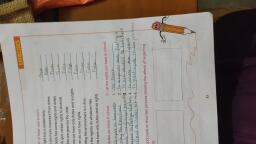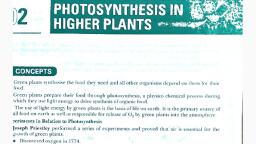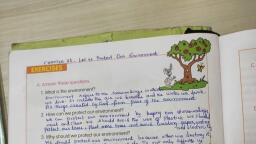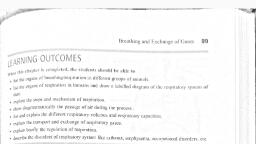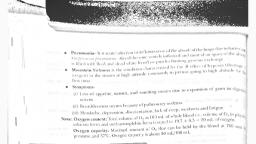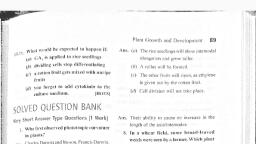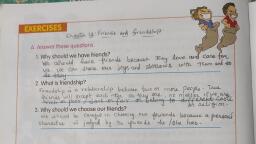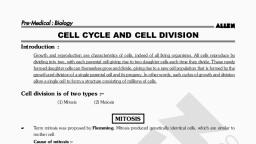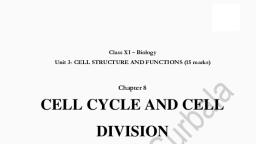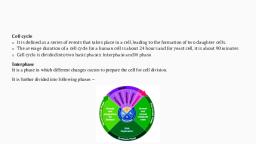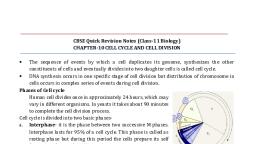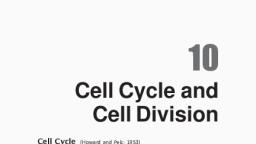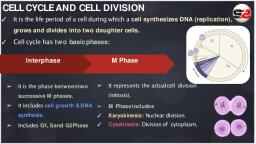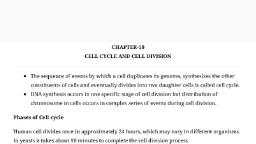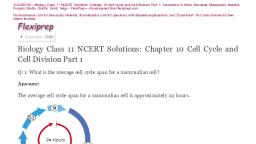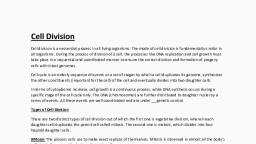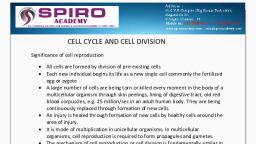Page 2 :
ts should be able to, , , , sion. :, wee co ihe evens in el 8, occur during interphase:, , , , vents in meiosis., ro) ofie different stages ol, ificance of meiosis., ° ee eee mitosis and meiosis., « distinguish, , £ meiosis., , , , , , IMPORTANT CONCEPTS, , , , , , j og i licates its, é mt CELLCY f events by which a cell duplicates its genome, synthesis,, os = 2 ot and utiately divides into two daughter cells, C5 th, other ee new cells are formed from the pre-existing cells, is called ce! vision,, © The process ie cell growth, DNA replication and cell division occur in an orderly and oye, i ae constituting the cell cycle., 1.1. Phases of Cell Cycle, , The following figure illustrates the cell cycle in human cells in culture., ., , M Phase, , , , , , Fig. 10.1 Cell Cycle, , , , Cell Cycle and Cell Division 11, , ® These cells divide approximately once every 24 hours. of which cell division proper (M-phase), , , , # The two major phases in a ¢, , , , , , (ii) Mitosis phase or M phase, , A. Interphase, , — Interphase is the most active stage in the, , the cell prepares for the, , , , , , vision phase., — It consists of three sub-stages:, (a) G, Phase or Gap-1 Phase, = Itcorresponds to the interval between, mitosis (M-phase) and i, replication of DNA; the ci, in size., (6) S Phase or Synthetic Phase, ™ It is the period during which DNA, replication takes place and the amount, of nucleic acid doubles., (c) G, Phase or Gap-2 Phase, = During this phase, more RNAs and, proteins are synthesised in preparation, for mitosis and also for the growth of, cells., , , , B. M-Phase or Mitosis Phase, , — This phase represents the phase when the, actual cell division/mitosis occurs., , — It is the phase when the replicated DNA, , is distributed to the daughter nuclei in a, , , , , , (a) Karyokinesis, = It corresponds to the separation of, the daughter chromosomes into two, daughter nuclei, ie., it is the process, of division of nucleus., (6) Cytokinesis, => It corresponds to the, cytoplasm and the separation of the, two daughter nuclei into two daughter, cells., , , , , , , , (a), , (6), , an hour while the remaining is interphase, , . MITOSIS, , , , is the process in which the chromosomes, of a nucleus undergo longitudinal du, and their split halves migrate to the poles to, constitute two daughter nuclei, identical to, cach other and also to the parent nucleus., , It is also known as equational division, as the, number of chromosomes in the parent cell and, the daughter cells is the same., , , , , , , . Karyokinesis, , ~ Karyokinesis in mitosis is completed in four, stages:, (a) Prophase, (c) Anaphase, Prophase, = The characteristic or key features are:, © Chromosomal material condenses to form, compact mitotic chromosomes; each is, composed of two chromatids attached, together at the centromere., tion of the assembly of mitotic spindle, by the microtubules of the cell cytoplasm., Metaphase, = Condensation of the chromosomes is, complete and the chromosomes are the, thickest and shortest in this phase., = The spindle formation is complete and all, the chromosomes lie at the equator; one, chromatid of each chromosome is attached, by the kinetochore to the microtubules, from one pole, while its sister chromatid, is attached by its kinetochore to the, microtubules of the opposite pole., = The key features of metaphase are:, © Spindle fibres attach to kinetochores of, chromosomes., © Chromosomes are moved to spindle, equator and get aligned along metaphase, plate through spindle fibres to both poles., , (6) Metaphase, (d) Telophase
Page 3 :
salogyen ll, wh? Biolony, 12 ae, , and the centromeres, plitsimultancously:, alongwith one, <The wt ed the daughter, ehromatid,, , chromosome. mes begin their, chromosot, wo The daughter, , wards the poles., f anaphase are:, 5 ll and chromatids separate., i atids commence their movement, 0 Chrom:, , to oppasite poles., , (a) Telophase, @ The chromosome:, respective poles:, = Thechromosomes, and become thin an‘, , individuality. /, ve Nuclear membrane, nucleolus, golgi, , complex and endoplasmic reticulum also, reappear. ;, = The key features of telophase are: /, © Chromosomes cluster at opposite spindle, poles and their identity 1s lost., , s have reached their, , start theirdecondensation, .d long; they lose their, , (2) Early prophase, Centriole, (asle), Daughter., chromosomes, (e)Anaphase, , (f Telophase, , , , , , ‘© Nuclear envelope assembles around the, chromosome clusters,, , © Nucleolus, golgi bodies and endoplasmic, reticulum are formed,, , Cytokinesis, — [tis the process of division of cytoplasm,, where the two daughter nuclei become, separated into two daughter cells., ~ The process differs in animal and plant cells,, Significance of Mitosis, (i) In multicellular organisms, body growth, is by mitotic divisions of the cells, (ii) Replacement of worn out tissues/cells, (eg,, blood cells, skin cells) and repair, of the injured tissues is by mitoses,, , , , (iil) In unicellular organisms, mitoses are, involved in asexual reproduction (multiplication of cells)., , (iv) Inplants, vegetative propagation involves, only mitotic divisions and genetically, identical individuals are produced., , (v) Uncontrolled cell divisions in certain, tissues/organs (cancer) result in tumours,, , , , , , =, , (b) Late prophase (c) Transition to metaphase (d) Metaphase, , Daughter cell, , Daughter cell, , ae, (g) Cytokinesis, , Fig. 10,2 Stages of Mitosis, , , , Cell Cycle and Cell Division 13, 10.4, MEIOSIS, © Meiosis is a type of «:, , , , division where the number of chromosomes is reduced to half in the, daughter cells; hence it is also known as reduction division, , * Meiosis occurs during different stages in the life cycle of different organisms., 10.4.1. Meiosis 1, A, Karyokinesis, “= It consists of Prophase I, Metaphase I, Anaphase I and Telophase |, (a) Prophase 1, © It consists of complex events and is divided into five stages., (0) Leptotene, , — Condensation and coiling of chromatin fibres lead to formation of distinct chromosomes, which appear as fine single threads of beads, ~> As they contract and become thicker, their dual nature is seen,, (ii) Zygotene, , , , , — The homologous chromosomes start pairing (synapsis)., , > It is accompanied by the formation of synaptonemal complex; the chromosomes, occur as bivalents,, , (iii) Pachytene, ~> The two sister chromatids of each chromosome become visible and the bivalent, becomes a tetrad (with four chromatids),, > Recombination nodules, the sites of crossing over appear., + Crossing over is catalysed by enzyme, recombinase., (iv) Diplotene, > Diplotene is marked by the dissolution of synaptonemal complex and the, , homologous chromosomes start separating from each other except at the sites of, crossing over, i.e., chiasmata,, , (v) Diakinesis, ~ The chiasmata move to the tip (terminalisation) and may slip off or remain at, the tips., > Diakinesis represents the transition to metaphase |., (6) Metaphase I, © The bivalents (tetards) are arranged at the equator of spindle., © The centromeres are aligned in two rows., (c) Anaphase 1, , © The members of every homologous pair of chromosomes separate from each other and, start moving to the opposite poles of the spindle; the centromeres do not spl, , © The number of chromosomes becomes half the number of chromosomes of the parent, cell.
Page 4 :
east piotony—!!, ”, " a etre Te he ii clusters at each pole., t, , o The forms around, membrane, ‘0 Anuclear me, , ‘dig:, first nuclear divisio, — follows the fi, B generally 0" yao formed., , gq rwo dhe cells (dyads), , ¢. Interkinests cae “x, a rion of DNA; sometimes this p!, , wThere i500, , TANK:, OES e, , Telophase |, , 1 and meiosis Hl, een meiosis, eae hase may be absent., , Metaphase | Anaphase |, , >. Prophase!, : Fig, 10.3 Stages of Meiosis-1, 194.2. Metosis II, ~ his similar to mitosis ant, Il,, - oe ‘of Prophase Il, Metaphase I, Anaphase Il and Telophase, (a) Prophase I, © The nuclear membrane disappears, 5 Qi pot., (b) Metaphase 1S, © A bipolar spindle is completely formed,, ‘© The chromosomes become arranged at the equator of the spindle., (¢) Anaphase IS ‘, © The centromere of each chromosome divides into two., © The sister chromatids separate and move to the opposite poles as, (d) Telopbase It, © The chromosomes have reached the poles,, © They start uncoiling and become thin,, ©The nuclear membrane and nucleolus start reappearing to form daughter nuc ei., , 1 it is also an equational division., , and chromosomes start condensing and become com, daughter chromosomes, , , , Cell Cycle and Cell Division 15, , B. Cytokinesis, "= The nuclei are separated into two cells by cytokinesis,, = Each daughter cell (dyad) of meiosis I divides to form two daughter cells and hence at the end, of meiosis of a diploid cell (meiocyte), four haploid daughter cells are formed, 10.4.3, Significance of meiosis, (/) This ensures the maintenance of a constant chromosome number, characteristic of a particular, species, generation after generation., (ii) The crossing over results in variation of genetic characters in the offspring; variations form, the raw material for evolution., , aoe, 9-23-80, , —, , ne, , \, , t, , g, , A, , A), , Prophase II Metaphase I Anaphase I Telophase I!, , Fig. 10.4 Stages of Meiosis-II, , NCERT EXERCISES, , 10.1. What is the average cell cycle span for a mammalian cell?, Ans. 24 hours., 10.2, Distinguish cytokinesis from uaryouinedi, , , , , Itis the process of division of eyioplasm. =. Its the process of division of nucleus,, ~ It corresponds to the separation of the two | ~ It corresponds to the separation of the daughter, , daughter nuclei into two daughter cells. chromosomes into two daughter nuclei, , , , 10.3. Describe the events taking place during interphase,, Ans. Interphase, (a) Interphase is the most active stage in the cell cycle, when the cell prepares for the division, phase.
Page 5 :
<1 Phase, , tothe interval between mitos', , jis (M-phase) and initiation OF replication, , Phase, (a SPhase oF Synthetic which DNA replication takes place and the amount of nucle, , le?, aa, Waa G,(qlescent phase of el Ie, @ nt phase) represents an, am - Ge in the cell cycle, where, inactive stage :, cells are metabolically active but do, at undergo division, unless it becomes, to replace any worn out or, se call!, ~ Cells from G, phase enter the Ga phase., 10-5, Why is mitosis called equational division?, \ms. Since the number of chromosomes in the, parent cell and the daughter cells is the, ‘same, mitosis is called equational division., ms ‘Name the stage of cell cycle at which each, of the following events occurs:, @) Chromosomes are moved to spindle, equator., (®) Centromere splits and chromatids, ‘separate., (Q Pairing between homologous, = chromosomes takes place., © Crossing over between homologous, * chromosomes takes place., Ams. (a) Metaphase, ), Asaphase of mitosis and anaphase Il, of meiosis., » ©) Zyeehene of prophase J of meiosis, A) Pachyrene of prophase I of meios, , , , , , 10.7. Describe the following:, ~ (q) synapsis (5) bivalent (c) chiasmata, Draw a diagram to illustrate your answer,, ‘Ans. (a) Synapsis, — Synapsis refers to the pairing of, homologous chromosomes during, zygotene of prophase I of meiosis., — It is accompanied by the formation, of a synaptonemal complex., (6) Bivalent, — The complex formed by the, pair of synapsed homologous, chromosomes, is called a bivalent., = Ascondensation of the chromosomes, continues, each chromosome shows, two chromatids held together by, the centromere; at this stage, the, bivalents are referred to as tetrads, (c) Chiasmata, , — Chiasmata are the X-shaped, structures formed at the points, of cross overs, between the non, sister chromatids of homologous, chromosomes., , — It is the result of the tendency, of the recombined homologo¥, chromosomes of the bivalents '°, , — separate from each other except a, the points of crossovers., , , , tk, , , , Cell Cycle and Cell Division 17, , 10.8. How does cytokinesis in plant cells differ from that in animal cells?, , Ans. Cytokinesis in Plant Cells. | Cytokinesis in Animal Cells, , It starts with the formation of cell plate, | — It starts as a constriction in the cell membrane, during telophase. during late anaphase or early telophase, , , , , , , , , , The cell plate grows from the centre, towards the lateral walls and divide the cell, into two; so it is described as centrifugal, , The furrow deepens from the periphery towards, the centre and meets at the centre and divide the, cell into two; so it is described as centripetal, , , , 10.9. Find examples where the four daughter cells from meiosis are equal in size and where they, are found unequal in size., , ‘Ans. (i) Four microspores formed by meiosis in a microspore mother cell, are equal, (i) Four spermatids formed from a spermatocyte, are equal., , (iii) When primary oocyte undergoes meiosis I, a large secondary oocyte and a small cell, the, polar body are formed; they are unequal, , 10.10. Distinguish anaphase of mitosis from anaphase I of meiosis., , , , — The centromere of every chromosome divides. | - The centromeres do not divide., , |, — Only one chromatid of every chromosome | ~ Both the chromatids of one member of |, (now called daughter chromosome) moves to| each homologous pair of chromosomes |, , the pole, move to the pole as the centromere does, not divide., , ~The chromatids moving to one pole are | ~ The chromosomes moving to one pole are, genetically identical to those moving to the| not genetically similar to those moving to, opposite pole. the opposite pole., , 10.11. List the main differences between mitosis and meiosis., SG Gia Micon Ana a uae, , ~ Two daughter cells are formed. — Four daughter cells are formed., , — For every duplication of the DNA, there is | — For every duplication of DNA there are two, one division of nucleus and cytoplasm. nuclear and cytoplasmic divisions., , — The daughter cells receive the same number | ~ The daughter cells receive half the number of, of chromosomes as the parent cell. chromosomes as the parent cell., , — The daughter cells are different among, themselves and do not resemble the parent cell., , , , , , , , , , , , , , , , , , — The daughter cells are identical to the parent, cell and between themselves., , = It occurs in all cells ~ haploid, diploid, ete. | ~ It occurs in diploid cells or cells with even, number of sets of chromosomes., , ~ Prophase | is typically a longer phase., , — Synapsis and crossing over are characteristics, , — Prophase is not as long as prophase I, — Synapsis and crossing over do not occur.



